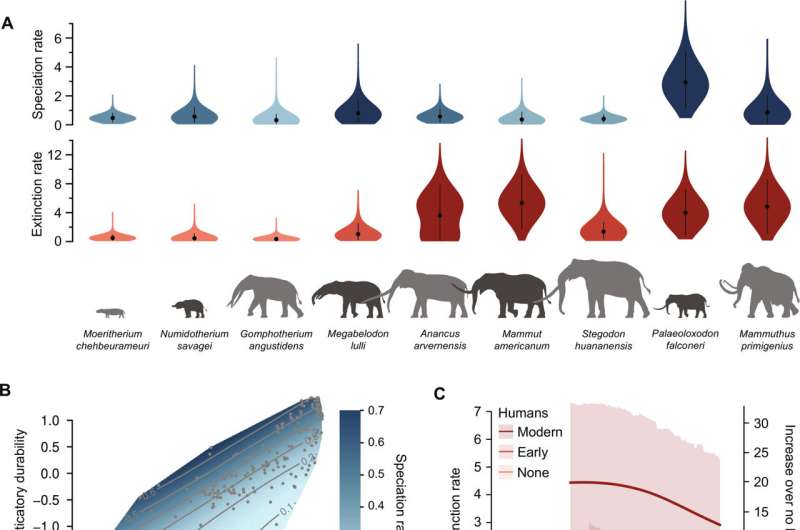AI-assisted analysis suggests elephant-like species extinction rates grew when humans arrived

A pair of paleobiologists at the University of Fribourg and Swiss Institute of Bioinformatics, in Switzerland, working with a colleague from Museo Nacional de Ciencias Naturales, in Spain, has found evidence suggesting that humans were responsible for proboscidean species extinction rates increasing over the past 1.8 million years.
In their paper, published in the journal Science Advances, Torsten Hauffe, Daniele Silvestro and Juan Cantalapiedra, describe how they used an AI application to provide insight into extinction rates for proboscidean species over a nearly 2-million-year span.
Prior research has suggested that hunting by early modern humans and climate change were responsible for the demise of several species of proboscideans, which included wooly mammoths and mastodons. In this new study, the researchers found evidence suggesting that the evolution of humans led to the extinction of nearly 30 species of trunked animals over millions of years.
Understanding the factors that cause an animal to go extinct, especially in the distant past, can be challenging to say the least. In most cases there were multiple factors, such as changes to an environment or ecosystem, changes in physiology, or the introduction of a new predator.
Because of this, most studies on the extinction of a given creature from the distant past have focused on a single factor. To overcome this problem, the researchers used a neural network-based AI system that allowed extinction assessments using large numbers of factors.
To use the system, the research team input fossil and other data for 2,118 proboscidean species going back 35 million years. They also fed the system 17 physiological and environmental factors that could have impacted the chances of a species' survival. This included the arrival of the first humans on the scene approximately 1.8 million years ago, and the ascent of modern humans 129,000 years ago.
When the team ran the system, it showed the largest single factor involved in raising extinction rates for up to 30 species of proboscideans, was the presence of humans—and it began shortly after humans arrived on the scene. The system also showed that rates of extinction grew even faster after modern humans arrived. Today, just three elephant species survive.
More information: Torsten Hauffe et al, Trait-mediated speciation and human-driven extinctions in proboscideans revealed by unsupervised Bayesian neural networks, Science Advances (2024). DOI: 10.1126/sciadv.adl2643
Journal information: Science Advances
© 2024 Science X NetworkSlower metabolism of warm-blooded animals on islands correlated with higher risk of anthropogenic extinction
No comments:
Post a Comment